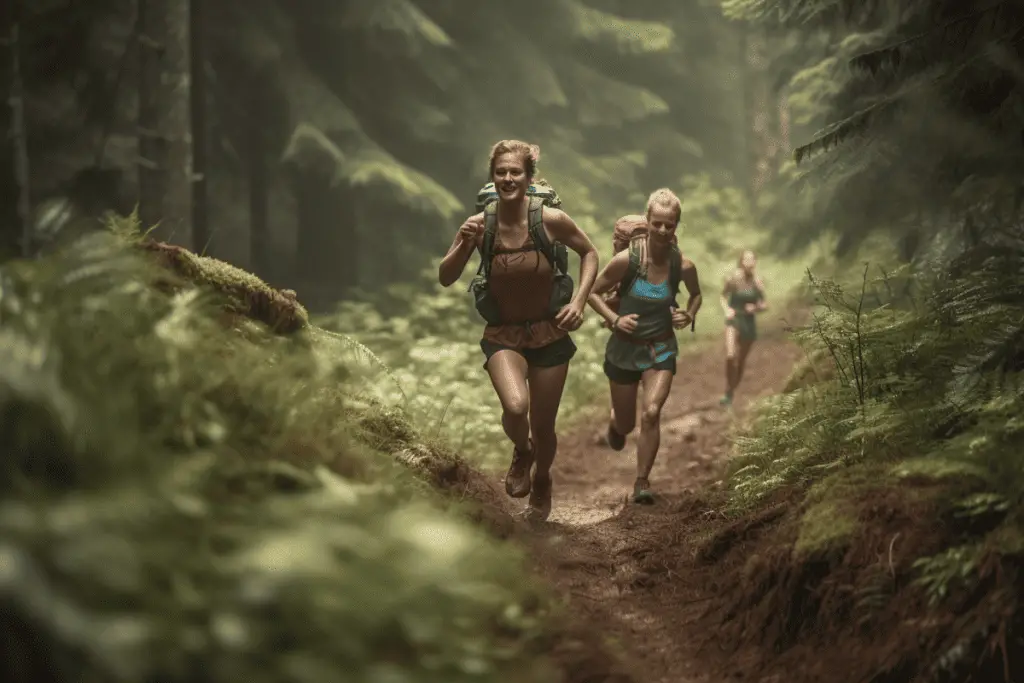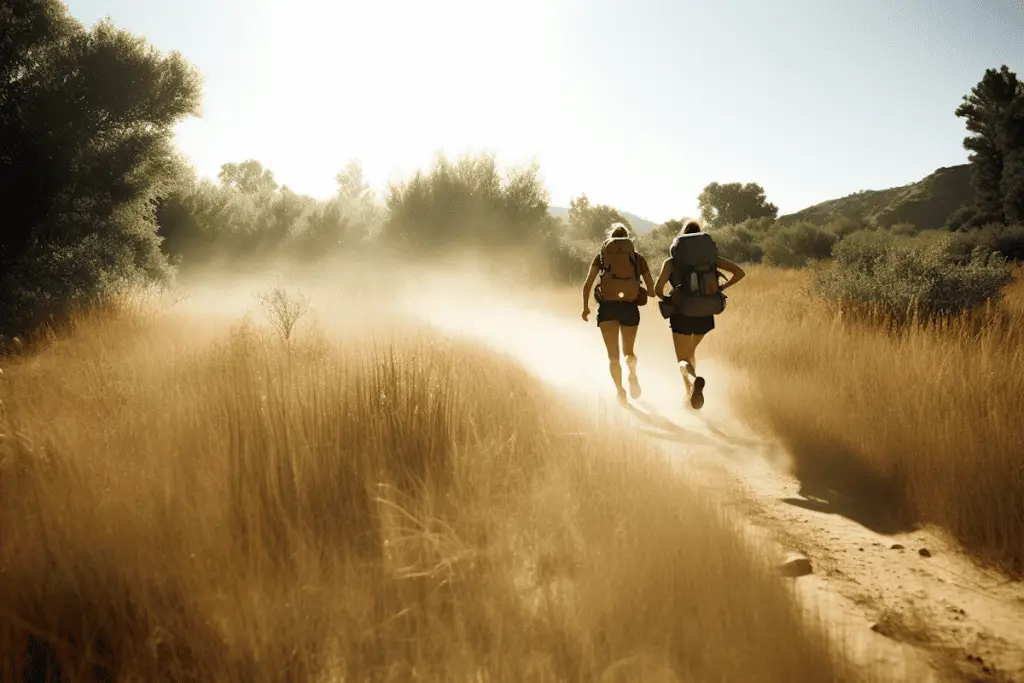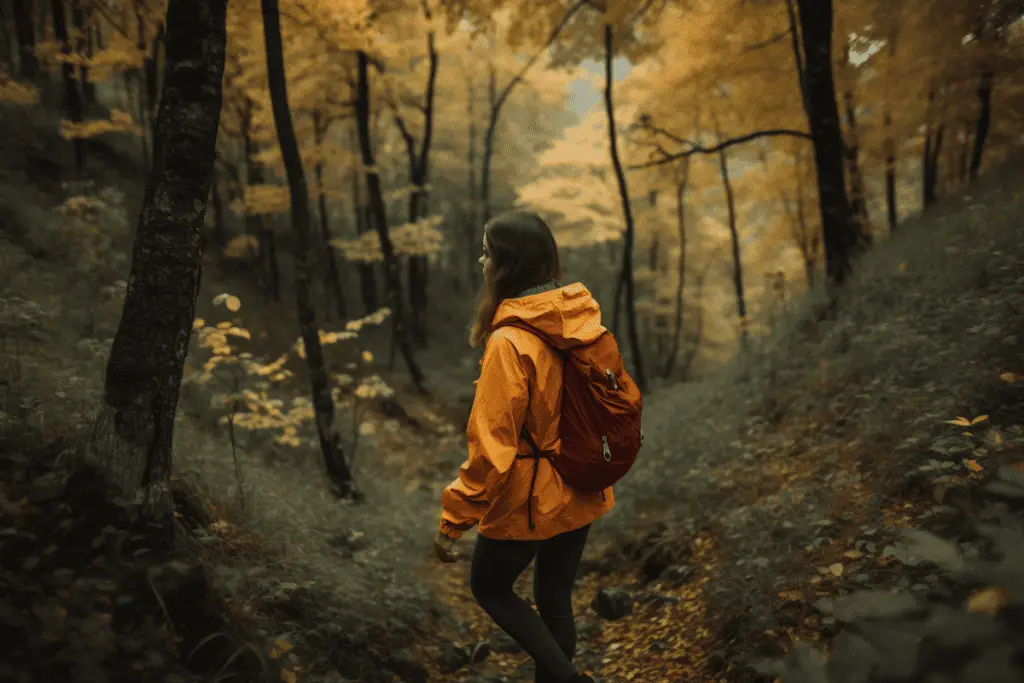Planning a hike is much easier when you know your average hiking speed. In this post, I’ll go over why hiking speeds matter, how to determine your hiking speed, and I’ll even tell you how to hike faster.
Just want to know what the average hiking speed is? I’ve created a table that will give you the averages. This table is based on Naismith’s rule for determining average hiking speeds.
Naismith’s rule is a basic rule of thumb that allows you to calculate time estimates for hiking based on distance and elevation gain. It doesn’t directly provide a measurement of speed but is rather used to estimate the time required to hike a certain distance.
According to Naismith’s rule:
- Allow 1 hour for every 3 miles (4.8 kilometers) forward, plus
- Allow 1 hour for every 2,000 feet (600 meters) of ascent.
However, if we reverse-engineer these figures to estimate a rough average speed, we might get a table like this:
| Elevation Gain (Feet) | Average Hiking Speed (Miles Per Hour) | Average Hiking Speed (Kilometers Per Hour) |
|---|---|---|
| 0 (Flat terrain) | 3.0 mph | 4.8 kph |
| 1,000 | 2.5 mph | 4.0 kph |
| 2,000 | 2.0 mph | 3.2 kph |
| 3,000 | 1.6 mph | 2.6 kph |
| 5,000 | 1.2 mph | 1.9 kph |
| 7,000 | 0.9 mph | 1.4 kph |
| 10,000 | 0.6 mph | 1.0 kph |
| 13,000+ | 0.4 mph | 0.6 kph |
It’s crucial to note that these are rough estimates and actual speeds will depend on many factors including the individual’s fitness level, the steepness of the terrain, the weight of the backpack, weather conditions, and whether the person is acclimatized to high altitudes. Furthermore, Naismith’s rule is a rough guide and may not be entirely accurate for all hikers or all types of terrain.
Kick-starting Your Hiking Journey: Why Average Hiking Speed Matters
Whether you’re a seasoned hiker or a newbie just dipping your boots into the wild, understanding your average hiking speed is crucial. Now, you may be wondering, “Why does it matter? I just want to enjoy the trails!” And that’s perfectly valid – enjoying the journey is what hiking is all about. But knowing your average speed can actually enhance your hiking experience in many ways.
First off, it’s a great tool for planning your hikes. Knowing how fast you usually move allows you to accurately estimate how long a trail will take, helping you better allocate your time and resources. Imagine setting out on a beautiful 10-mile trail expecting it to take three hours, but you find out midway it’s likely going to take five! An accurate understanding of your speed can help you avoid such scenarios.

Furthermore, being aware of your average hiking speed helps you track your fitness progress. As you trek more often and your body gets used to the activity, you’ll likely see an increase in your speed – a rewarding sign that you’re becoming a more efficient hiker. On the flip side, if your speed decreases, it could be an indicator that something is off, like you’re overdoing it or perhaps not getting enough rest or nutrition.
Lastly, and perhaps most importantly, understanding your hiking speed can ensure your safety. If you’re caught out on a trail as darkness falls or a storm moves in, things can quickly turn from fun to risky. By knowing your average speed, you can make sure you’re back safely before such situations arise.
So, let’s delve into this fascinating aspect of hiking and see how we can use it to make our adventures even more enjoyable. Grab your hiking poles, and let’s hit the trail – at the perfect pace!
Unpacking the Pace: What Determines Your Hiking Speed?
There’s no one-size-fits-all when it comes to hiking speed. Just as each trail has its unique twists and turns, your hiking speed can also be influenced by a variety of factors. Here’s the lowdown on what could be accelerating or slowing down your pace on the trails.
How Fast Do Fit People Hike?
First up, your fitness level and health play a significant role. The fitter you are, the faster and longer you can hike without tiring. Age and overall health also come into play – younger and healthier individuals often have more stamina, but that’s not to say older or less fit hikers can’t hold their own. It’s all about knowing your body’s limits and working within them.
So, how fast do fit people hike? On average, fit hikers can maintain a speed of 2 to 3 miles per hour (3 to 5 kilometers per hour) on well-maintained trails with moderate terrain and minimal elevation gain. This pace includes occasional breaks for rest and hydration.
What Is The Average Speed of a Backpacker?
Your backpack’s weight can also impact your speed. The more you carry, the slower you’ll likely move. So it’s worth considering if you really need that extra pair of shoes or bulky camera on your hike.
So, what exactly is the average speed of a backpacker? Generally, a backpacker maintains a slower pace compared to a day hiker, averaging around 1.5 to 2.5 miles per hour (2.5 to 4 kilometers per hour) on established trails with moderate terrain and a loaded backpack. This speed takes into account the additional weight carried and the need for regular breaks for rest, hydration, and enjoying the surroundings.
Let’s Talk Terrain
Now, let’s talk about the terrain. Flat, well-maintained trails will generally allow for faster hiking speeds. However, throw in steep inclines, rocky paths, or loose sand, and you’ll naturally slow down to navigate these obstacles safely.
If you want to see the average hiking speed based on elevation, just take a look at the chart at the top of this post. It’s based on Naismith’s rule, so it’s not an exact science but it does provide a basic benchmark for you.
The Weather
The weather can also be a game-changer. Extreme heat can drain your energy quickly, reducing your speed. Similarly, cold conditions or heavy rainfall can make trails slippery and challenging, meaning you’ll need to tread more cautiously and slowly.
If you find yourself struggling with the weather, check out our guide for hiking in the rain as well as our guide for hiking in hot weather.
Elevation
Elevation is another crucial factor to consider. Hiking at high altitudes, especially when you’re not acclimatized, can lead to slower speeds due to the thinner air and potential altitude sickness.
Hiking Experience
Last but not least, your hiking experience and skill level can affect your speed. Seasoned hikers often move faster due to their experience, skills, and familiarity with pacing themselves over different terrains.
As you can see, multiple factors can influence your hiking speed, and understanding them can help you manage your pace effectively. But remember, it’s not a race. Hiking is about enjoying the journey as much as reaching the destination.
Measuring Your Miles: Guide to Tracking Your Hiking Speed
Now that we’ve talked about what influences your speed, let’s delve into the practical stuff: How do you actually track your hiking speed? Don’t worry, you don’t need to be a math whiz or a tech guru to figure this out. Here are a few easy ways to keep tabs on your pace on the trails.
The traditional way to calculate your hiking speed is by using the old-school method of time and distance. Simply divide the total distance of your hike (in miles or kilometers) by the total time you took to complete it (in hours). This will give you your average speed. Of course, this means you’ll need to know the length of your trail and keep track of your start and finish times.

For those of us who love our gadgets, tech has made tracking speed as easy as a few taps on our smartphones. Numerous hiking apps available can not only track your speed in real-time but also record your route, distance, and elevation gain. Some popular ones include AllTrails, Gaia GPS, and MapMyHike. Just remember to keep an eye on your battery life, as these apps can drain it pretty quickly!
Another device that many hikers swear by is a GPS watch. These nifty wearables provide real-time data on your speed, distance, elevation, and even heart rate in some models. They are generally more accurate and consume less battery than smartphones. Brands like Garmin, Suunto, and Polar offer some excellent options.
Don’t forget that tracking your speed is not just about numbers. It’s about understanding your abilities, planning your hikes effectively, and ensuring you’re hiking in a safe and sustainable way. So, equip yourself with these tools and techniques, and you’ll be well on your way to mastering your pace on the trails!
Gaining Momentum: How to Hike Faster
So, you’re interested in quickening your pace on the trails? Excellent! Increasing your hiking speed not only means you can cover more ground, but it can also improve your overall fitness and make your hikes more challenging and enjoyable. Here are some tips and tricks to help you train for faster hiking speeds.
1. Be Consistent
First, consistency is key. Just like any other sport, the more you hike, the better and faster you’ll get. Try to get out on the trails regularly, increasing your distance gradually. Consistent practice will build your hiking-specific muscles and improve your endurance, naturally increasing your speed over time.
2. Consider Cross Training
Next, consider adding some cross-training to your routine. Incorporating activities like running, cycling, or swimming can enhance your cardiovascular fitness, which in turn can boost your hiking speed. Strength training, especially for your core and lower body, can also be beneficial. After all, strong legs make for fast hikers!
3. Interval Train
Another useful technique is interval training. This involves alternating between periods of intense effort and periods of lower-intensity recovery. For example, you could hike as fast as you can for one minute, then slow down for a few minutes, and repeat. This kind of training can help increase your overall hiking speed.
4. Improve Your Form
When you’re out on the trail, focus on your form. Maintain an upright posture and use your arms for balance and momentum. Try to keep a consistent pace and avoid starting too fast, which can lead to early fatigue.
5. Lighten Your Load
And let’s not forget about gear. Lightening your load can instantly make you faster, so ensure you’re only carrying what you need. Also, invest in good quality hiking shoes – the right footwear can significantly improve your comfort and speed.
Remember, while speed can enhance your hiking experience, it’s not the only goal. The beauty of hiking lies in connecting with nature, finding peace, and pushing your own boundaries.
The Balance between Speed and Enjoyment in Hiking
As we wrap up our exploration of hiking speeds, it’s important to take a moment to remember the heart of hiking. Yes, understanding your pace, pushing your limits, and improving your speed can be an exciting part of the hiking experience. But at its core, hiking isn’t about how quickly you can reach the destination; it’s about the journey itself.
Hiking is about immersing yourself in the tranquility of nature, soaking in picturesque landscapes, and appreciating the beauty around every bend of the trail. It’s about the sense of accomplishment when you reach the summit and the peace you find in the gentle rhythm of your footsteps.

Always remember – the trail is best enjoyed at your own pace.
While improving speed can give you a sense of achievement and allow you to cover more ground, remember to balance this with the pleasure of the hike. Moving too fast might mean missing out on the small wonders around you – the bird’s song, the wind rustling the leaves, the sunlight filtering through the trees.
Use the knowledge of your average speed as a tool for planning your hikes and tracking your progress, not as a parameter for success or enjoyment. Some days, you might feel like challenging yourself and hiking faster. On other days, you might prefer a slow, leisurely walk. Both are equally rewarding and beneficial.
As you embark on your next hiking adventure, armed with insights on tracking speed and factors influencing it, remember to pause, take a deep breath, and enjoy the moment. After all, each hike, each trail, and each step offer a unique experience to cherish. Always remember – the trail is best enjoyed at your own pace.
